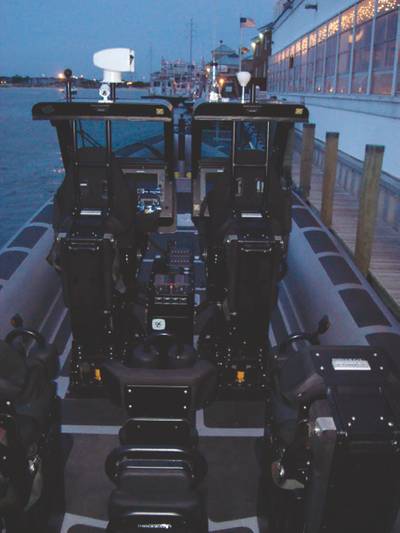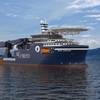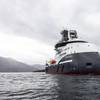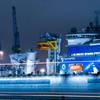Speed & Control @ MACH2
Speed.
When Zodiac unveiled its Hurricane MACH2 earlier this year, its eye-popping 60+ knot speed caught the attention of potential military and port security clients. "Today, if you're not 50 knots plus, you're not in the running," said J.J. Marie, president, Zodiac, at the Mach2's in-water running earlier this summer at the MACC 2008 exhibition, While the 11-m RIB is indeed fast, powered by a trio of 300-hp Mercury outboards as tested in Virginia, the boat is designed to be a flexible, easy-to-modify platform which combines speed, stability and performance in fulfilling the needs of military, security and commercial customers. Based on Maritime Reporter's ride, it would seem that Zodiac design has delivered.
"The Hurricane Mach 2 is designed to deliver speed in a very safe way," Marie said. "Usually when you add speed, you lose something else. In this case we have not."
Key to the vessel's performance is its twin-step hull design, Naval Architect, Michael Peters, designed a patented two-step hull and proprietary keel to handle the speeds and maintain stability. MACH2 is an acronym for "Military Air-Channeled Hull" the 2 for the two steps. The lateral steps reduce drag in the water, accounting for efficiency gains. While more speed is generally considered the easier part, the hard part being maintaining control at the higher speeds. The air-channel running the length of the keel provides the answer.
"This hull has the predictability of a Deep V, but it is 15% more speed efficient than a Deep V (meaning that it will, on the same power, be 15% faster than a Deep V design)," Marie said.
Combined with the speed and stability is shock mitigating technology in seating configurations and deck surface, designed to enhance the military's mission. It features a fully-suspended integrated helm. By integrating the seats and the helm, the pilot's console moves in-sync with the seats (and pilot's eyes) making it easier to monitor the instruments.
As is the mandate across most marine military and security products, an emphasis is placed on flexibility, and with this in mind the MACH2 is designed to be quickly and easily reconfigured to meet changing personnel and cargo needs; it is air-droppable to ensure it can be used when it's needed, where it's needed; and it can be fitted with ArmorFlate, a system that provides protection against small arms fire.
On display at MACC and operated in the capable hands of Jake Albinio (see related story below left), the boat performed as promised in a short run through relatively calm waters off the Virginia coast. Albinio took the boat through its paces to highlight its acceleration and speed, as well as its maneuverability, handling tight turns with the need to only slightly reduce the throttle.
"It's a technical marvel to combine this level of speed in a boat and not beat the crew up with the added shock and G-forces involved with skipping across waves," said Marie. "Zodiac's main focus is always crew safety first. Without the shock mitigating technology we've helped to pioneer, this boat would be too much. With the technology, it's an amazingly tame ride so our guys can arrive at their mission ready to go." The MACH2 is offered in the 11m size, and current plans do not call for an expansion of boat sizes. However, it is intended that the MACH2 hull will be tested in small sizes as an option across the entire Hurricane range.
Pick Your Propulsion
The 11-m Hurricane Mach2 is available with several propulsion options, based largely on the need and preference of the customer, as well as the operating conditions. In general, the options are as follows:
• Inboard - jet drive: This solution is needed for vessels that will be stern-ramp launched and recovered, and the primary customer for this is the Coast Guard. The benefit: when piloting the boat into the notch for recovery, there are no dangling props to be damaged on recovery.
• Inboard - surface-piercing drive: This solution is for when speed is one of the greatest requirements. The surface-piercing drives are strong enough to transfer the power from the engines with the least amount of horsepower loss. This solution is for "offshore" missions where the boats launch from a dock rather than another boat. Potential customers include, but are not limited to, the Coast Guard, specifically units specializing in interdiction, boarding, and port security. (for example The new Coast Guard MSRT (Military Special Response Team) was an initial customer).
• Outboard engines: This solution has a significant advantage over inboard systems: maintenance. If an engine goes down at sea, and the mission can't be slowed, postponed, or aborted, the military simply drops a new outboard in place and carries on. Field repairs are easier, with fewer tools and workspace. Special Forces Units, Navy SEALs and RECON Marines are prime targets for this configuration. Not much speed is lost, and the 24/7 availability is critical.
www.zodiacmilpro.com
(Reprinted from the August 2008 edition of Maritime Reporter & Engineering News)














